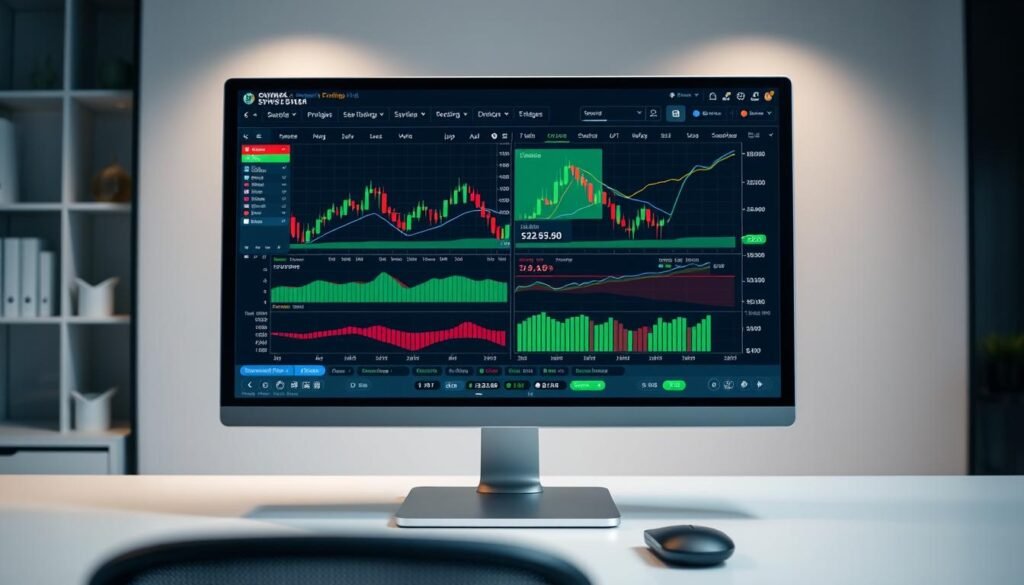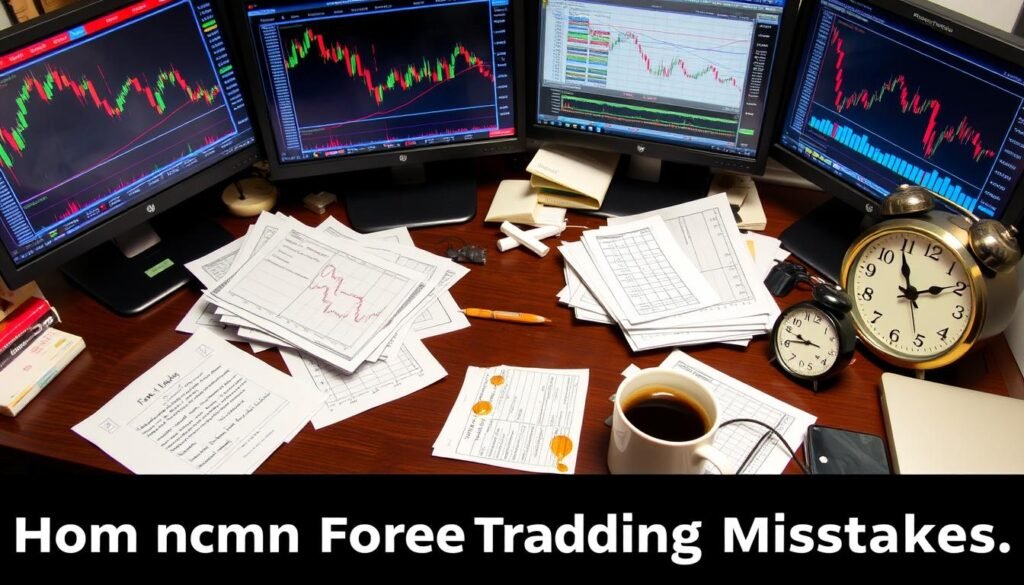Forex Trading in Canada: Guide for Beginners
Welcome to your guide to forex trading in Canada. This article is for everyone, whether you’re new or experienced. It will teach you the basics and help you understand the foreign exchange market. You’ll learn how to start your forex trading journey with confidence.
Key Takeaways
- Forex trading in Canada offers unique opportunities for investors to diversify their portfolios and capitalize on global market movements.
- The guide covers the basics of the forex market, including major currency pairs and their significance.
- Readers will learn how to choose a regulated broker, set up a trading account, and access the various trading platforms and tools available in Canada.
- Strategies for effective risk management, such as implementing stop-loss and take-profit orders, are discussed.
- The guide also addresses the regulatory landscape and taxation considerations for forex trading in Canada.
What is Forex Trading?
Forex, or the foreign exchange market, is the biggest financial market globally. It’s where people trade one currency for another to make money from rate changes. Traders buy and sell currency pairs like USD/CAD, EUR/GBP, or JPY/CHF.
Understanding the Foreign Exchange Market
The forex market is open 24/7, five days a week. It’s not in one place but happens worldwide. Banks, big investors, companies, and individuals trade here. They do this based on economic news, politics, and global trade.
Major Currency Pairs and Their Significance
The top major currency pairs are USD/CAD, EUR/USD, and GBP/JPY. These show the exchange rates of big economies. Knowing what affects these pairs is key for forex trading success.
| Currency Pair | Description |
|---|---|
| USD/CAD | This pair shows the US dollar to Canadian dollar rate. It’s a key indicator of the US economy’s strength and its global trade impact. |
| EUR/USD | The EUR/USD is the most traded pair. It reflects the Euro to US dollar rate. It gives insights into the Eurozone and US economic health. |
| GBP/JPY | The GBP/JPY pair shows the British pound to Japanese yen rate. It’s used to see trader risk appetite. The yen is safe, while the pound is volatile. |
Knowing the major currency pairs and their factors is vital for starting forex trading in Canada.
Why Trade Forex in Canada?
For Canadian investors, the foreign exchange (forex) market is full of opportunities. It offers easy access to the global market, high liquidity, and the chance to trade at any time. These benefits make forex a great choice for Canadian traders wanting to grow their portfolios.
Advantages of Forex Trading for Canadian Investors
One big plus of why trade forex as a Canadian is the market’s huge size and liquidity. The forex market is the largest financial market in the world. It gives Canadian traders many chances to make money from the benefits of forex trading in Canada. Also, the market’s high volatility can lead to big gains, attracting those who like a dynamic trading scene.
Another advantage is the ability to trade 24/7, five days a week. This lets Canadian investors take advantage of market changes in different time zones. It gives them flexibility and the chance to react quickly to global economic events.
Lastly, forex trading is easy to start with and offers leveraged trading. This makes it open to traders of all levels. The mix of accessibility and diversification makes it a strong choice for Canadian investors looking to why trade forex as a Canadian.
| Advantages of Forex Trading for Canadians | Description |
|---|---|
| Accessibility | The forex market is the world’s largest financial market, offering ample opportunities for Canadian traders to participate. |
| Liquidity and Volatility | The forex market’s high liquidity and volatility can provide the potential for substantial gains. |
| Global Trading | Canadian investors can trade across different time zones, allowing them to capitalize on market movements around the clock. |
| Diversification | The forex market provides Canadian traders with the opportunity to diversify their investment portfolios. |
| Leverage | Leveraged trading in the forex market makes it accessible for Canadian traders of all experience levels. |
“The forex market is a compelling choice for Canadian investors seeking to capitalize on global economic trends and diversify their portfolios.”
Getting Started with Forex Trading in Canada
Starting your forex trading journey in Canada is exciting and rewarding. But, it’s important to understand the market and the steps to begin. Here’s a beginner’s guide to help you get started with forex trading in Canada.
- Understand the Forex Market: Start by learning about the foreign exchange market. Know its mechanics and the key currency pairs. This will help you build a strong trading strategy.
- Develop a Trading Plan: A good trading plan is essential. It should outline your investment goals, risk tolerance, and trading strategies. A solid plan will guide you to success.
- Choose a Reputable Forex Broker: Picking the right forex broker in Canada is key. Look for brokers that are well-regulated, offer good platforms, have low fees, and provide excellent customer support.
- Open a Forex Trading Account: After choosing a broker, open a trading account. You’ll need to provide personal and financial details and meet the broker’s requirements.
- Fund Your Account: Put the initial capital into your account. Make sure it fits your risk management strategy and financial situation.
- Practice with a Demo Account: Many brokers offer demo accounts. These let you practice trading without risking real money. Use this chance to improve your skills and test strategies before live trading.
By following these steps, you can start your forex trading journey in Canada on the right foot. Remember, successful trading takes patience, discipline, and a commitment to learning and self-improvement.
| Key Steps to Begin Forex Trading in Canada |
|---|
| 1. Understand the Forex Market |
| 2. Develop a Trading Plan |
| 3. Choose a Reputable Forex Broker |
| 4. Open a Forex Trading Account |
| 5. Fund Your Account |
| 6. Practice with a Demo Account |
“Patience and discipline are the keys to successful forex trading. Take the time to learn, and never stop improving your skills.”
Choosing a Forex Broker in Canada
Finding the right forex broker is key for Canadian traders. It’s important to pick a broker that offers a safe and rewarding trading experience. When looking for the best forex brokers in Canada, there are several factors to consider.
Factors to Consider When Selecting a Broker
Regulation and licensing are top priorities. Make sure your broker is registered and regulated by the Investment Industry Regulatory Organization of Canada (IIROC) or the Canadian Securities Administrators (CSA). This protects your funds and ensures the broker follows strict rules.
Also, think about the trading platform’s ease of use. Check the variety of currency pairs available. The broker’s reputation is also important. Good customer support and clear pricing, including competitive spreads and commissions, are key when how to choose a forex broker in Canada.
Regulated Forex Brokers in Canada
Here’s a list of some top regulated forex brokers in Canada to consider:
- OANDA – IIROC-regulated broker with a wide range of currency pairs and advanced trading platforms.
- TD Direct Investing – CSA-regulated, a major Canadian bank’s subsidiary, offering a full forex trading solution.
- Questrade – IIROC-regulated, known for its easy-to-use platform and competitive prices for forex traders.
- FOREX.com – IIROC-regulated, famous for its strong research and educational tools.
- IG – A well-known, IIROC-regulated broker with a focus on innovation and client service.
By carefully looking at these best forex brokers in Canada and thinking about your trading needs, you can choose wisely. This will help you start your forex trading journey with confidence.

Setting Up a Forex Trading Account
Starting your forex trading journey in Canada means setting up a trading account. You need to know about the different account types and their features. This helps you pick the right one for your trading goals and how much risk you’re willing to take.
Types of Forex Trading Accounts in Canada
In Canada, you can choose from several forex trading account types:
- Standard Accounts: These need a bigger deposit, from $2,000 to $10,000. They offer more leverage, letting you use more market power.
- Mini Accounts: Mini accounts need less money, about $500 to $1,000. They have smaller contract sizes, good for those who like to play it safe or have less money.
- Micro Accounts: Micro accounts are for new traders or those with little money. You only need to deposit $100 to $250. The contract sizes are the smallest of all.
It’s key to meet the forex trading account requirements in Canada. This includes showing your ID, proof of address, and using approved ways to fund your account.
| Account Type | Minimum Deposit | Leverage | Contract Size |
|---|---|---|---|
| Standard | $2,000 – $10,000 | Up to 1:500 | Standard (100,000 units) |
| Mini | $500 – $1,000 | Up to 1:200 | Mini (10,000 units) |
| Micro | $100 – $250 | Up to 1:100 | Micro (1,000 units) |
Knowing about the different account types and their features helps Canadian traders choose the right forex trading account. This choice should match their trading style and risk level.
Forex Trading Platforms and Tools
Canadian forex traders have access to many powerful tools and platforms. These help improve your trading experience and results. They offer the features needed to navigate the forex market effectively.
MetaTrader 4 (MT4) is a favorite among Canadian traders. It has a user-friendly interface and advanced charting. It also comes with technical analysis tools. Many Canadian brokers offer MT4, making it a top choice for traders.
MetaTrader 5 (MT5) is another popular choice. It offers more features than MT4, like trading stocks and commodities. MT5 also has faster execution and advanced order types.
- Popular forex trading platforms in Canada include MT4, MT5, and proprietary platforms offered by leading Canadian forex brokers.
- Forex trading tools and software in Canada can include technical analysis tools, risk management tools, economic calendars, and market news feeds.
- When selecting the best forex trading platforms for Canadians, consider factors such as user-friendliness, platform features, execution speed, and the broker’s overall reputation and regulatory standing.
| Platform | Key Features | Broker Support |
|---|---|---|
| MetaTrader 4 (MT4) |
|
Supported by many leading Canadian forex brokers |
| MetaTrader 5 (MT5) |
|
Gaining popularity among Canadian forex brokers |
Canadian traders also have access to many analytical and risk management tools. These include economic calendars, market news feeds, and automated trading systems. These tools provide insights, help find trading opportunities, and manage risk.
“The right trading platform and tools can be the difference between success and failure in the forex market.”
Choosing the right forex trading platforms and tools in Canada is crucial. It can improve your decision-making, execution, and success in the forex market.

Understanding Forex Trading Strategies
If you’re a Canadian trader in the forex market, knowing your strategies is key. Two main methods are technical and fundamental analysis. These are especially important for Canadian traders.
Technical Analysis Techniques for Forex Trading
Technical analysis looks at price charts and patterns to find trading chances. In Canada, some top techniques include:
- Chart patterns: Spotting shapes like triangles and head and shoulders to guess price moves.
- Trend analysis: Following market trends with tools like moving averages and trendlines.
- Momentum indicators: Using RSI and Stochastic Oscillator to see trend strength.
Fundamental Analysis in Forex Trading
Fundamental analysis looks at economic factors that affect currency prices. Canadian traders can use it by watching:
- Economic indicators: GDP, employment, inflation, and interest rates show the Canadian economy’s health.
- Geopolitical events: Political news, trade deals, and global policies can change the Canadian dollar’s value.
- Market news and sentiment: Following expert opinions and news to understand market feelings.
By mixing technical and fundamental analysis, Canadian traders can craft a strong strategy. This strategy fits their risk level and goals.
“Successful forex trading is not just about identifying the right signals, but also about managing risk and maintaining discipline. A balanced approach that incorporates both technical and fundamental analysis can give Canadian traders a significant edge in the market.”
Risk Management in Forex Trading
Effective risk management is key in the fast-changing world of forex trading in Canada. Using stop-loss and take-profit orders is crucial for Canadian traders. These tools help limit losses and protect trading capital.
Implementing Stop-Loss and Take-Profit Orders
Stop-loss orders prevent big losses by closing a trade when it goes against the trader. Take-profit orders lock in gains by closing a trade at a good price. These orders help traders manage risks and emotions, avoiding big losses.
Experienced traders in Canada also use other strategies. These include:
- Proper position sizing: Choosing the right trade size based on account size and risk tolerance
- Diversification: Spreading investments across multiple currency pairs to reduce risk
- Disciplined trading plan: Following a clear trading strategy and risk rules
By using a wide range of risk management strategies, Canadian traders can face the forex market with confidence. This approach improves their chances of success over time.
“Successful forex trading is not about making big gains, but about consistently protecting your trading capital and minimizing losses.”
| Risk Management Strategy | Description | Benefits |
|---|---|---|
| Stop-Loss Orders | Automatically close a trade when the market moves against the trader’s position and reaches a pre-defined level. | Limits downside risk and potential losses. |
| Take-Profit Orders | Close a trade once the market reaches a favorable price target, locking in gains. | Helps traders secure profits and manage emotions. |
| Position Sizing | Determining the appropriate trade size based on account size and risk tolerance. | Ensures proper risk exposure and prevents over-leveraging. |
| Diversification | Spreading investments across multiple currency pairs to reduce overall portfolio risk. | Minimizes the impact of losses in any single trade or currency pair. |
Forex Trading in Canada: Regulations and Taxation
If you trade forex in Canada, knowing the rules and taxes is key. The forex market here is watched closely by important bodies. They make sure the market is fair and open.
The Investment Industry Regulatory Organization of Canada (IIROC) and the Canadian Securities Administrators (CSA) lead the way. They set rules for brokers and traders. These rules cover things like how to manage client accounts and follow anti-money laundering laws.
When it comes to taxes, forex profits in Canada are seen as business income. This means you have to pay income tax on them. You’ll need to report your trading wins and losses on your tax forms each year.
- Forex trading regulations in Canada are overseen by IIROC and CSA, ensuring industry standards and client protection.
- Forex trading taxes in Canada treat trading profits as business income, requiring traders to report gains and losses on their tax returns.
- Complying with the legal requirements for forex trading in Canada is essential for Canadian traders to operate within the law.
Knowing the rules and taxes of forex trading in Canada helps traders. It lets them trade with confidence and follow the law.
“Forex trading in Canada is a regulated industry, and it’s crucial for traders to stay informed about the latest rules and guidelines to ensure they are operating legally and responsibly.”
Psychology of Forex Trading
The psychology of forex trading is key for Canadian traders. It’s about having a winning mindset to handle the market’s ups and downs. This means being disciplined, emotionally strong, and aware of your biases.
Developing a Winning Mindset
For success in forex trading in Canada, you need more than just skills. You must have a disciplined and emotionally stable mindset. This includes:
- Being patient and self-aware to manage fear, greed, and other biases.
- Practicing emotional management in forex trading in Canada to stay focused and objective.
- Being adaptable and able to change strategies as the market changes.
By having a successful mindset for forex trading in Canada, you can reduce emotional impact on your decisions. This leads to more consistent and profitable trades.
“The greatest obstacle to forex trading success is not the market, but the person standing in the mirror.” – Anonymous
The psychology of forex trading for Canadians is as vital as technical skills. Mastering your mental game is the secret to lasting success in foreign exchange.

Continuing Education and Resources
As a Canadian forex trader, your learning journey should never end. The forex market keeps changing, and it’s key to keep up with new trends and strategies. Luckily, there are many educational resources and ongoing learning chances to help you grow your skills.
Online Courses and Seminars for Forex Traders
Online courses and webinars are great ways to learn more about forex trading in Canada. These interactive sessions, led by experts, cover many topics. You’ll learn about analysis, risk management, and trading psychology.
- Check out online forex trading courses for Canadians that teach the basics of the market and trading strategies.
- Join live webinars and virtual seminars to learn about the latest in the forex world and gain insights from experienced traders.
- Use forex trading resources for Canadians, like articles, video tutorials, and market reports, to understand the market better.
Investing in your continued education is a crucial step in becoming a successful and confident forex trader in Canada.
“The more you learn, the more you earn.” – Warren Buffett
By using these learning resources, you’ll improve your trading skills and appreciate the forex market’s complexities. Remember, a trader’s journey is ongoing. Embrace the chance to grow, adapt, and become a more informed and versatile forex trader in Canada.
Common Mistakes to Avoid in Forex Trading
Forex trading is exciting but can be tough, especially for new traders in Canada. Knowing the common mistakes helps you trade better. This way, you can do well in the foreign exchange market.
One big mistake is using too much leverage. Canadians might want to make more money fast. But, using too much leverage can cause big losses. It’s important to manage your risk well to keep your money safe.
Not having a clear trading plan is another mistake. Without a plan, you might make quick, emotional decisions. These can hurt your profits. A good plan, based on solid research, helps you trade with confidence.
Not managing risk well is a big mistake for beginners. Not using stop-loss orders can lead to big losses. Learning to manage risk is crucial for success in forex.
By avoiding these mistakes, Canadian traders can do better in forex. Remember, patience, discipline, and learning are key to a good trading strategy.

“The key to successful forex trading is not about making the perfect trade, but about minimizing your losses and protecting your capital.”
Forex Trading Strategies for Beginners
Starting in forex trading in Canada means using simple yet effective strategies. These can help you move through the foreign exchange market. Here are some easy forex trading strategies for beginners:
Trend-Following Strategy
The trend-following strategy is a classic. It involves finding and using the overall direction of a currency pair. By looking at price charts and technical indicators, you can spot the trend. Then, you can buy when the trend is up and sell when it’s down.
This strategy is great for Canadian beginners. It helps you understand the market better.
Breakout Trading
Breakout trading is about spotting big price movements. These happen when a currency pair breaks out of a certain range or pattern. By watching key support and resistance levels, beginners can find breakout chances. They can then enter the market, hoping for a big price move.
Scalping
Scalping is fast and focuses on small profits from minor price changes. Beginners can make many trades a day. This way, they aim to make small gains add up over time. Scalping needs discipline and a good understanding of the market.
As a Canadian beginner, it’s key to know these strategies well. Practice with a demo account and make a solid trading plan. Keep practicing, manage risks, and always learn more. These steps are crucial for success in forex trading.
| Strategy | Description | Key Considerations |
|---|---|---|
| Trend-Following | Identifying and capitalizing on the overall direction of a currency pair | Analyzing price charts and technical indicators to identify trends |
| Breakout Trading | Taking advantage of significant price movements when a currency pair breaks out of a defined trading range or pattern | Monitoring support and resistance levels to identify potential breakout opportunities |
| Scalping | Capturing small, frequent profits by taking advantage of minor price movements | Executing multiple trades throughout the day with a disciplined approach and understanding of market dynamics |
Using these beginner forex trading strategies in Canada can help you build a strong foundation. Remember, simple forex trading strategies for Canadians work well with discipline, risk management, and a commitment to learning.
Automated Forex Trading: Pros and Cons
Automated trading systems are becoming popular in Canada. These systems use algorithms to make trades. They promise consistent results and less emotional bias, thanks to their ability to analyze lots of data.
But, there are downsides to automated trading in Canada. It’s important to consider these before starting.
Automated trading can be very consistent and precise. It can make trades fast and accurately, which is hard for humans to do. It also looks at a lot of data to find patterns and opportunities.
This is great for Canadians who want a systematic way to trade.
However, relying on technology has risks. Systems can fail, markets can change suddenly, or there can be errors in the code. This can lead to big losses. Canadians using these systems need to watch them closely and be ready to step in when needed.
Also, automated systems might miss important details in the market. This shows the value of understanding the trading logic behind them.
